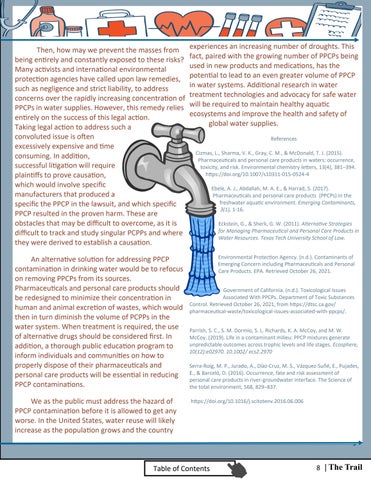Volume 14 | Issue 1
Then, how may we prevent the masses from being entirely and constantly exposed to these risks? Many activists and international environmental protection agencies have called upon law remedies, such as negligence and strict liability, to address concerns over the rapidly increasing concentration of PPCPs in water supplies. However, this remedy relies entirely on the success of this legal action. Taking legal action to address such a convoluted issue is often excessively expensive and time consuming. In addition, successful litigation will require plaintiffs to prove causation, which would involve specific manufacturers that produced a specific the PPCP in the lawsuit, and which specific PPCP resulted in the proven harm. These are obstacles that may be difficult to overcome, as it is difficult to track and study singular PCPPs and where they were derived to establish a causation. An alternative solution for addressing PPCP contamination in drinking water would be to refocus on removing PPCPs from its sources. Pharmaceuticals and personal care products should be redesigned to minimize their concentration in human and animal excretion of wastes, which would then in turn diminish the volume of PCPPs in the water system. When treatment is required, the use of alternative drugs should be considered first. In addition, a thorough public education program to inform individuals and communities on how to properly dispose of their pharmaceuticals and personal care products will be essential in reducing PPCP contaminations. We as the public must address the hazard of PPCP contamination before it is allowed to get any worse. In the United States, water reuse will likely increase as the population grows and the country
experiences an increasing number of droughts. This fact, paired with the growing number of PPCPs being used in new products and medications, has the potential to lead to an even greater volume of PPCP in water systems. Additional research in water treatment technologies and advocacy for safe water will be required to maintain healthy aquatic ecosystems and improve the health and safety of global water supplies. References Cizmas, L., Sharma, V. K., Gray, C. M., & McDonald, T. J. (2015). Pharmaceuticals and personal care products in waters: occurrence, toxicity, and risk. Environmental chemistry letters, 13(4), 381–394. https://doi.org/10.1007/s10311-015-0524-4 Ebele, A. J., Abdallah, M. A. E., & Harrad, S. (2017). Pharmaceuticals and personal care products (PPCPs) in the freshwater aquatic environment. Emerging Contaminants, 3(1), 1-16. Eckstein, G., & Sherk, G. W. (2011). Alternative Strategies for Managing Pharmaceutical and Personal Care Products in Water Resources. Texas Tech University School of Law. Environmental Protection Agency. (n.d.). Contaminants of Emerging Concern including Pharmaceuticals and Personal Care Products. EPA. Retrieved October 26, 2021. Government of California. (n.d.). Toxicological Issues Associated With PPCPs. Department of Toxic Substances Control. Retrieved October 26, 2021, from https://dtsc.ca.gov/ pharmaceutical-waste/toxicological-issues-associated-with-ppcps/. Parrish, S. C., S. M. Dormio, S. L. Richards, K. A. McCoy, and M. W. McCoy. (2019). Life in a contaminant milieu: PPCP mixtures generate unpredictable outcomes across trophic levels and life stages. Ecosphere, 10(12):e02970. 10.1002/ ecs2.2970 Serra-Roig, M. P., Jurado, A., Díaz-Cruz, M. S., Vázquez-Suñé, E., Pujades, E., & Barceló, D. (2016). Occurrence, fate and risk assessment of personal care products in river-groundwater interface. The Science of the total environment, 568, 829–837. https://doi.org/10.1016/j.scitotenv.2016.06.006
Table of Contents
8# | The Trail



